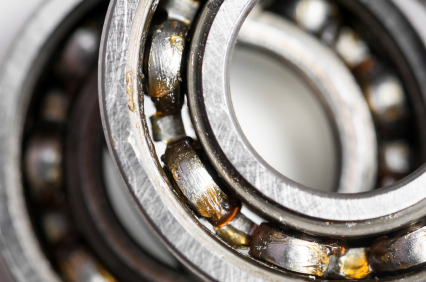How to Prevent Ball Bearing Failure

Ball bearing failure can be costly, inconvenient and in some cases dangerous. If a ball bearing is misused, lubricated incorrectly or put under strain from its working environment then it is likely to fail, and regular ball bearing failure is something most industries simply cannot afford. Below is a brief guide to the main causes of ball bearing failure as well as suggested remedies, which should keep your machinery in good working order.
Causes of Bearing Failure:
Improper Use: The layman might consider ball bearings to be a pretty simple and, therefore, robust mechanism. It’s true that the theory behind ball bearings is wonderfully simple, but this doesn’t mean that the manifestation of such a theory is without intricacy. If ball bearings aren’t used appropriately then they are extremely likely to fail. Inappropriate use includes excessive loading which can cause brinelling and reverse loading. Brinelling is the result of excessive loads working on the ball bearing which results in “brinell” marks around the raceways increasing bearing vibration. Reverse loading is when an angular contact bearing, designed to accept a load in only one direction, is loaded in the opposite direction. The result is excessive stress, increased temperature and increased vibration.
An Unhealthy Environment: The atmospheric environment a ball bearing is subjected to can have huge implications for functioning. High temperature (which can be caused by other failings increasing friction, and therefore, temperature also) can lead to loss in hardness and morphing. Contamination is probably the leading cause of bearing failure and this normally occurs due to a messy a working environment. To prevent grit, dust and other undesirables getting into your bearing it’s a good idea to keep your working area as clean as possible. Another factor in an unhealthy environment is exposing bearings to corrosive substances or a corrosive environment. A corrosive environment can include inappropriate humidity (i.e. moisture becomes corrosive) or an environment where chemicals are prevalent in the air.
Lubrication Problems: If you have any experience whatsoever with maintaining machinery or ball bearings then you’ll have some idea of how pivotal proper lubrication is. Use too much, or too little, and serious damage can be inflicted. False brinelling happens over a period of time and is the result of lubricant being pushed out of a mechanism because the bearing is struggling to redistribute lubricant properly. It results in similar “marks” on the bearing to brinelling (hence the name) but is the result of a different problem. High temperatures can likewise seriously effect lubrication. If it’s too hot the lubricant itself can degrade. Discoloured balls and ball tracks indicate lubricant failure.
Other Problems: Other problems can include how the bearing is fitted in the raceway. Misalignment, a loose fit or a tight fit can all leave to undue wearing.
Common Sense and Simple Solutions:
Simple solutions to avoid bearing failure which can be avoided include ensuring the environment a bearing is working in is suitable. This means maintaining proper temperature, humidity and cleanliness. It might seem like an extra expense to make sure a decent environment is maintained, but the overall savings made by not having to replace machinery will make it a worthwhile investment. Lubrication is always tricky, and it’s best to seak advice from a lubrication distributor to make sure you’re using the right stuff in the right way. To avoid corrosion investing in sealed bearings might be a good call.
Combine all of these little titbits with your own experience and you’re likely to keep your bearings in good working order. The key is to be vigilant and pay a lot of attention to detail to make sure you don’t make silly (and costly) mistakes.
